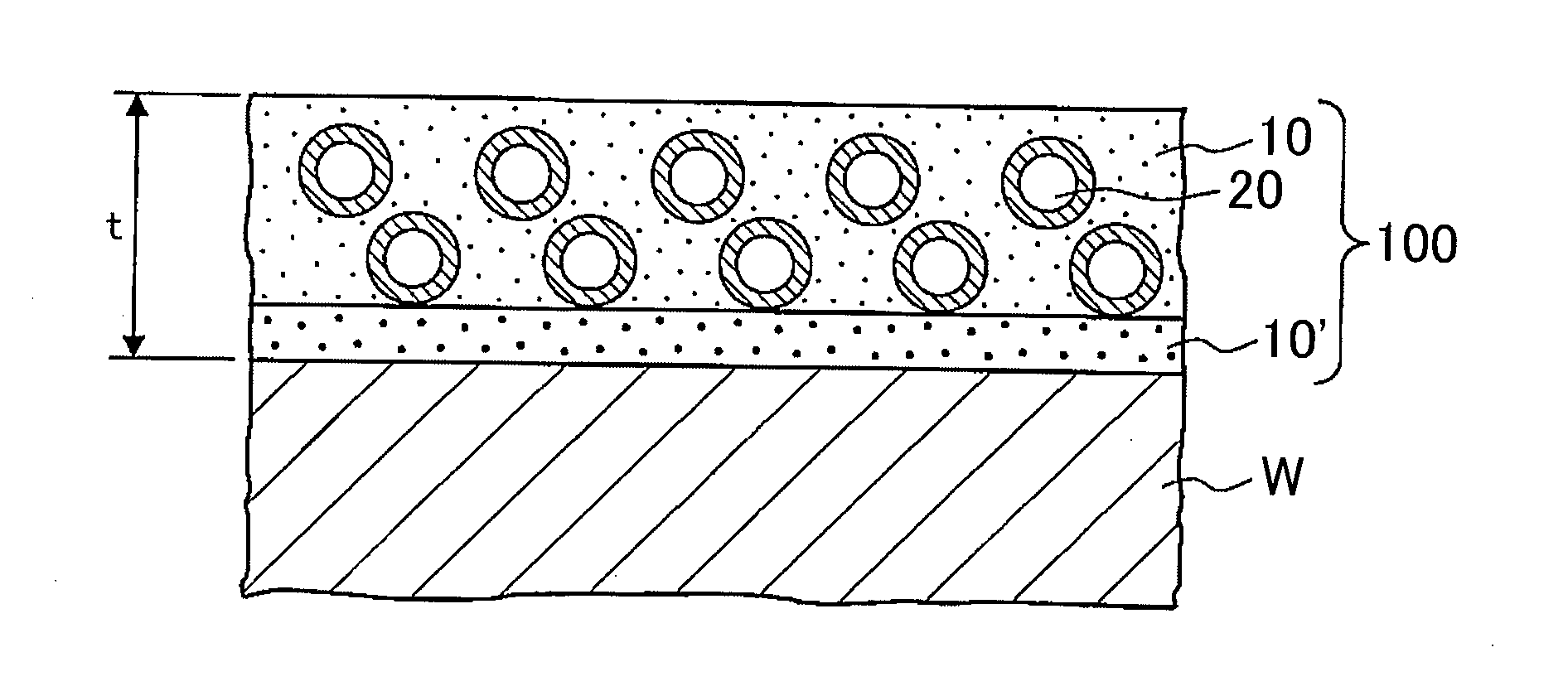Heat shield film and method of forming heat shield film
a heat shield film and heat shield technology, applied in the direction of machines/engines, mechanical equipment, cylinders, etc., can solve the problems of low volumetric specific heat, low heat insulation film deformation, and low thermal conductivity, and achieve low volumetric specific heat, low thermal conductivity, and high interfacial strength
- Summary
- Abstract
- Description
- Claims
- Application Information
AI Technical Summary
Benefits of technology
Problems solved by technology
Method used
Image
Examples
first embodiment
[0053]FIG. 1 is a longitudinal cross-sectional view that shows the heat shield film. An illustrated heat shield film 100 is formed of a matrix layer 10 made of a porcelain enamel material and hollow particles 20 dispersed inside the matrix layer 10. Part of the matrix layer 10 constitutes a diffusion bonding layer 10′, and is formed on a wall surface of an aluminum-based member W. The thickness t of the heat shield film 100 is about 100 μm.
[0054]Because the heat shield film 100 is formed on the wall surface of the aluminum-based member W, a raw material compatible with the aluminum-based member W is employed as the porcelain enamel material forming the matrix layer 10.
[0055]The porcelain enamel material is formed of a material mixing a vanadium-based glass frit with a glaze. The heat shield film 100 has a coefficient of linear expansion of 15×10−6 / K to 25×10−6 / K in a temperature range of ordinary temperature to 200° C., and has a coefficient of linear expansion substantially equal t...
second embodiment
[0064]FIG. 3 is a longitudinal cross-sectional view that shows the heat shield film. An illustrated heat shield film 100A has a two-layer structure formed of an upper layer 10A and a base layer 10B adjacent to the wall surface of the member W (the diffusion bonding layer 10′ is included in the base layer 10B). The base layer 10B contains no hollow particles. Only the upper layer 10A contains the hollow particles 20. Each of the thickness t1 of the upper layer 10A and the thickness t2 of the base layer 10B is about 50 μm. In another embodiment, the base layer also contains the hollow particles, but the content of the hollow particles in the upper layer is relatively large.
[0065]The heat shield film 100A has a two-layer structure formed of the upper layer 10A and the base layer 10B adjacent to the wall surface, and the base layer 10B contains no hollow particles. Therefore, the base layer 10B has a lower firing temperature than the upper layer 10A, so the glass frit of the base layer ...
PUM
| Property | Measurement | Unit |
|---|---|---|
| temperature | aaaaa | aaaaa |
| glass transition temperature | aaaaa | aaaaa |
| heat-resistant temperature | aaaaa | aaaaa |
Abstract
Description
Claims
Application Information
 Login to View More
Login to View More - R&D
- Intellectual Property
- Life Sciences
- Materials
- Tech Scout
- Unparalleled Data Quality
- Higher Quality Content
- 60% Fewer Hallucinations
Browse by: Latest US Patents, China's latest patents, Technical Efficacy Thesaurus, Application Domain, Technology Topic, Popular Technical Reports.
© 2025 PatSnap. All rights reserved.Legal|Privacy policy|Modern Slavery Act Transparency Statement|Sitemap|About US| Contact US: help@patsnap.com



